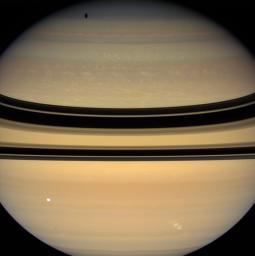
|
Hissing Storm
- Click the image above for a larger view
- Full-Res JPEG (1016 x 1021) (57.2 kB)
- Full-Res TIFF (1016 x 1021) (3.1 MB)
Caption:
A bright, powerful, lightning-producing storm churns and coasts along the lane of Saturn's southern hemisphere nicknamed "Storm Alley" by scientists.
NASA's Cassini spacecraft detected this particular tempest after nearly two years during which Saturn did not appear to produce any large electrical storms of this kind. The storm appears as a bright, irregular splotch on the planet near lower right.
Lightning flashes within the persistent storm produce radio waves, called Saturn Electrostatic Discharges, which the Cassini radio and plasma wave science instrument first detected on Nov. 27, 2007. Cassini's imaging cameras then spotted the storm, taking the images used to create this color view about a week later on Dec. 6.
This electrical storm is similar in appearance and intensity to those previously monitored by Cassini. All of these powerful electrostatic producing storms appeared at about 35 degrees south latitude on Saturn. (See PIA07788 , PIA08142 and PIA06197 for additional images of Saturn's electrical storms imaged by Cassini.)
This storm has now been continuously tracked by Cassini for several months, whereas previous storms observed by the spacecraft lasted for less than 30 days: See PIA08411 for images of the storm acquired three months after this view. The view looks toward the un-illuminated side of the rings from about 5 degrees above the ringplane. Tethys (1,071 kilometers, or 665 miles across) is seen here in the foreground, and casts its shadow onto the high northern latitudes.
Images taken using red, green and blue spectral filters were combined to create this natural color view. The images were acquired with the Cassini spacecraft wide-angle camera at a distance of approximately 1.7 million kilometers (1 million miles) from Saturn. Image scale is 97 kilometers (60 miles) per pixel.
Background Info:
The Cassini-Huygens mission is a cooperative project of NASA, the European Space Agency and the Italian Space Agency. The Jet Propulsion Laboratory, a division of the California Institute of Technology in Pasadena, manages the mission for NASA's Science Mission Directorate, Washington, D.C. The Cassini orbiter and its two onboard cameras were designed, developed and assembled at JPL. The imaging operations center is based at the Space Science Institute in Boulder, Colo. The radio and plasma wave science team is based at the University of Iowa, Iowa City.
For more information about the Cassini-Huygens mission visit http://saturn.jpl.nasa.gov/ . The Cassini imaging team homepage is at http://ciclops.org . The radio and plasma wave science instrument team home page is at http://www-pw.physics.uiowa.edu/plasma-wave/cassini/home.html .
Cataloging Keywords:
| Name | Value | Additional Values |
|---|---|---|
| Target | Saturn | Tethys |
| System | Saturn | |
| Target Type | Planet | Satellite |
| Mission | Cassini-Huygens | |
| Instrument Host | Cassini Orbiter | |
| Host Type | Orbiter | |
| Instrument | Imaging Science Subsystem (ISS) | |
| Detector | Wide Angle Camera | |
| Extra Keywords | Atmosphere, Color, Radio, Shadow, Storm, Visual | |
| Acquisition Date | ||
| Release Date | 2008-04-29 | |
| Date in Caption | 2007-11-27 | |
| Image Credit | NASA/JPL/Space Science Institute | |
| Source | photojournal.jpl.nasa.gov/catalog/PIA08410 | |
| Identifier | PIA08410 | |
